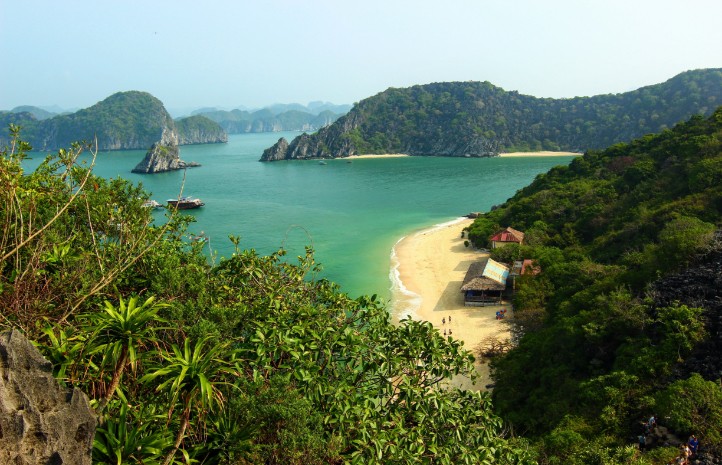
Vietnam and Cambodia
overview
If you’ve never been to Southeast Asia before, little can prepare you for the sheer difference between Vietnam and Cambodia. Vietnam’s mysterious coastline and verdant mountain ranges contrast with its high-speed cities, enigmatic temples and beautiful colonial buildings. Cambodia is tranquillity itself with its ancient floating villages and the incomparable Angkor Wat.…
+ Click to read more
VIETNAM
Hanoi has been Vietnam’s capital for almost a thousand years and offers the best of experiences, ancient and modern. The Ho Chi Minh Mausoleum is the final resting place of the man who declared Vietnam an independent nation almost seventy-five years ago. The Soviet-style design of the building is a nod to the grandeur of Lenin’s Mausoleum in Moscow and is a place of great reverence for the people. It sits cheek-by-jowl with a monument from the other end of the city’s historical spectrum, the eleventh century One-Pillar Pagoda. A deeply spiritual place it is constructed in wood built onto a single piece of stone and symbolises the thousand years of continuity and civilisation of the Vietnamese. Of similar age is the Temple of Literature (Van Mieu in Vietnamese), the country’s first university formerly the exclusive place of learning for mandarins and members of the royal family. This is Vietnamese architecture at its most alluring with its picturesque courtyards and altars.
Flying over Halong Bay in a seaplane it is easy to imagine oneself a Bond villain or Raiders of the Lost Ark-style adventurer. You will be captivated by the giant limestone islands topped with lush greenery and the gorgeous white sandy beaches. Cruising on Lan Ha Bay you can take a closer look in luxury and style en-route to Cat Ba Island where you will visit tiny villages hidden in a valley, sample the delicious local cuisine and be served cocktails as you watch the sun go down on this absorbing seascape.
You will visit the delightful Can Tho market where you can shop for all kinds of local delicacies before boarding a Mystic sampan for a cruise down the legendary Mekong River. This will take you to an ancient Khmer sanctuary surrounded by high walls with a stunning golden pagoda and a large statue of a reclining Buddha. It’s time to take to two wheels for a gentle ride through tranquil countryside and lunch at a small farm in the company of a local family.
The mode of transport to tour Ho Chi Minh City (still known locally as Saigon) is different again as you will ride through the city in a beautifully restored 1950s Jeep. Half of the people who live here are thirty-five or younger and it shows. Ho Chi Minh City is noisy, hectic and buzzes with a vibrant nightlife. This is one of the best places to get to sample the delicious Vietnamese cuisine and your guided tour will help you try the delights of banh xeo pancakes, succulent spring rolls and some of the finest seafood you will ever eat.
One of the most memorable and certainly most affecting places to visit in this land of enigmatic contrast is the Cu Chi tunnels. Thousands of soldiers lived here under the ground when they were first dug out by resistance fighters struggling to evict their French colonial overlords. When the Vietnam War began, the tunnels were greatly expanded eventually comprising 125 miles of interconnecting passages, each up to thirteen feet deep. This underground world was fully equipped for the waging of a long war and included hand-excavated weapons stores, hospitals and meeting rooms.
CAMBODIA
The name of the Cambodian capital, Phnom Penh, translates in its simplest form to the, “city of four faces,” after the four river channels which intersect its location. The Royal Palace is as stately and impressive as any of its European counterparts and houses treasures beyond value. The palace is split into four distinct compounds and has three impressive spires which dominate the surrounding structures. Inside one of the compounds, the Silver Pagoda, resides a solid gold Buddha weighing almost two hundred pounds and encrusted with just short of ten thousand diamonds. The entire palace is filled with unimaginable treasures, all part of the king’s royal collection.
The contrast could not be greater with Tuol Sleng. A perfectly normal secondary school until 1975, the Khmer Rouge turned it into a torture and execution centre. Cambodians would be brought here and brutalised until they gave up the names of family and friends as co-conspirators in some usually imagined plot against the government. They would be murdered and the people they named brought in to suffer the same fate. In a four year period nearly twenty thousand prisoners were taken to Tuol Sleng and at most a few dozen lived to leave again. Today the site has returned to its educational roots as the Genocide Museum, a sobering experience which will live long in the memory.
By the very act of booking a room at the Shinta Mani Wild tented camp you are already helping the fight to preserve Cambodia’s endangered wildlife. It’s been built in a narrow corridor between two national parks and its profits pay for a team of Wildlife Alliance Rangers who track poachers and illegal loggers. The area is one of the last in the country where bears, elephants, tigers and gibbons still live in the wild and where experienced rangers make sure their habitat is protected and nurtured. You will have the opportunity to go out on patrol with the team before taking a boat up a nearby river estuary to catch giant crabs which your butler will cook for you. A top chef will help you forage for the best edible plants while you assist and observe a group of naturalists with one of their vital research projects.
It would be strange to visit Cambodia without visiting Siem Reap and the fabled Angkor temple complex. The scale and grandeur of this city of religious structures is hard for the first-time visitor to take in. There is infinite variety in the design and decoration of the temples. The Bayon Temple is famous for the fifty-four towers which surround it, each carved with four giant faces. Bauphon is a three-tiered manmade mountain of a temple. Beside it are formidable two terraces from which the Khmer kings used to watch parades and ceremonies and make proclamations, the Terrace of the Elephants and the Terrace of the Leper King, both of which are covered with beautiful and elaborate sculptures.
The Srah Srang baray reservoir which looks like a lake was originally built as the royal baths. Close to this tranquil spot local families live in their timber village houses and warmly welcome guests to share their personal stories over a homemade, traditional Cambodian lunch. The two most famous buildings in the vast temple complex are Angkor Wat and Ta Prohm. The former is the largest religious monument in the world and is designed to represent the mountain home of the Hindu gods. The latter is the “tomb raider temple,” appearing to be being consumed by the jungle, overgrown with silk-cotton and strangler fig trees and looking like some strange architectural and natural hybrid, man’s ingenuity and earth’s instinctive beauty conjoined.
Suggested
Itineraries
Classic Vietnam
From culture to cuisine, from the deeply spiritual to the wild glory of nature, Vietnam will take your breath away. Take a seaplane to Lan Ha Bay and cruise the majestic Mekong River to find peace in a land shaped by war. The sights, tastes and smells of Vietnam will be with you forever.
Best of Cambodia
Colonial splendour meets the culture of centuries. Discover Cambodian civilisation at its most glorious in the legendary Angkor temple complex and at its most chilling in a former Khmer Rouge prison. Swim from gleaming white beaches and explore the traditional floating villages of this land of beauty and wonder.
Vietnam & Cambodia – Climate Guidance
Vietnam
Vietnam’s climate is as diverse as its landscapes with different seasons across the country. From March to May, the weather in the north is generally warm and dry with the rainy season starting in June. Humidity and heat can be high between May and October, with temperatures cooling off from November. Central Vietnam can experience periodic rain showers from September through to January, with the wettest months being December and January. Temperatures start to rise with August normally being the hottest month.
The south of Vietnam has a dry season from December through to April with a rainy season from May to November. This is often known as the ‘green season’, due to the lush and tropical landscapes created by the rains.
Cambodia
Cambodia tends to have little seasonal temperature variations with an average of 28°C (82°F) across the year. During the dry season from October to April, expect early starts for visiting Angkor Wat so that you can relax poolside during the main heat of the day. Influenced by the south west monsoons, the wet season in Cambodia is from May through to October. Rain can be heavy from July through to September, but visitors during this time get to experience the temples without the crowds. Also with the temple moats full, it’s a perfect time for some reflective photography.
Ready to discover more
Get in touch with us



